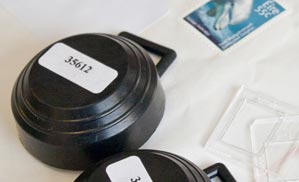What is Radon?
More about Radon Gas and How it could Effect You Testing at HomeTesting in the Work PlaceRadon: A Radioactive Gas
Radon is a colourless, odourless, radioactive gas which is created naturally by the breakdown of uranium and radium. Radon gas is continuously released from rocks and soil containing these two elements. Uranium and radium may be found in almost all soil and rock, but are most often associated with those containing limestone, granite, shale, and phosphate.
Once formed, radon itself decays into other radioactive elements, known as “radon daughters” or “progeny”. The rate at which a radioactive element decays is expressed as its half-life. (A half-life is the time it takes for half of a radioactive element in a sample to decay into another element.) Radon has a half-life of about three days; its daughter particles all have half-lives of less than half an hour.
The Health Hazards of Exposure to Radon
Radon exposure is the second leading cause of lung cancer deaths in Ireland, after smoking. Exposure to natural radon is estimated to be responsible for approximately 200 lung cancer deaths each year in Ireland. As with other forms of cancer, lung cancer resulting from exposure to radon may develop over many years before it is diagnosed.
Radon and its progeny can attach themselves to dust particles that may be inhaled and lodge in the lungs. Once there, these elements break down and emit radiation which can damage lung tissue and eventually cause lung cancer.
Are You Exposed to Radon?
The best way to reduce your risk of lung cancer due to radon is to reduce your exposure to radon.
How are people exposed to radon?
Radon gas continuously seeps into the air from uranium- and radium-bearing soil and rock. Outdoors, due to dilution in the ambient air, concentrations are generally so low that they are insignificant. However, if the gas becomes trapped in a poorly ventilated, enclosed space, the concentrations will build up. This can be a problem in any structure built on rocks or soil naturally emitting radon gas.
Any home may have elevated radon levels. Gaseous radon can enter a home through foundation cracks, openings for pipes, wall/floor joints, chimneys, sumps, unfinished crawl spaces, and hollow, concrete block foundations. Once inside, the gas may be trapped and accumulate, especially during the winter months when windows are seldom open.
If air pressure in the house is lower than that of the soil, radon gas may actually be pulled from the soil into the house. Reduced air pressure results from the use of exhaust fans (such as those in clothes dryers, kitchens, and bathrooms), and some home heating devices (such as fireplaces or central heating burners). Natural shifts in air pressure, such as those associated with a storm or strong winds may also alter indoor air pressure enough to draw radon gas into the home.
Usually eighty percent of any radon entering a house comes from the soil or rock on which the building is constructed. The balance is carried by water entering a house through water supply pipes, with a small percentage being emitted from materials used in construction of the house itself.
Safe levels of Exposure to Radon
No government standards define the amount of radon that is safe. The RPII has set a level of concern or “action level” for homes, above which remedial action should be considered. This radiation level is currently an annual average of 200 becquerels per meter cubed of air (Bq/m3).
The exposure rate at the action level is equivalent to having slightly more than 200 chest X-rays per year. With this exposure, approximately 2 out of every 1000 non-smokers would develop lung cancer over a 70-year period. This represents a lung cancer risk that is 9 to 12 times higher than that of people who have not been exposed to radon.
Tests show that radon exposure in conjunction with smoking greatly increase the risk of lung cancer, to a level higher than the sum of the risks of either radon exposure or smoking alone. This is called a synergistic effect, and it can have serious health consequences. For example, if exposed to a radon level of 200 Bq/m3 over a lifetime, approximately 30 out of 1000 smokers would develop lung cancer. The risk of lung cancer from smoking alone is approximately 10 chances out of 1000.
Children are more susceptible to the adverse effects of exposure to many toxic substances. This is especially true of carcinogens. Children may be more sensitive than adults to radon exposure, since their lung cells are rapidly dividing, their lungs are smaller, and their breathing rate is faster. However, the RPII action level figure was calculated for adults.
Household radon exposure has been targeted by the RPII because most of a person’s time is spent in the home; therefore, that is where the risk of radon exposure is greatest. If you spend most of your time in another indoor location — such as an office building or shop — you should be equally concerned about that exposure. If you have reason to believe that your place of work may have a radon problem, contact your employer or the building manager to ascertain if any tests have been performed or any remedial action taken. Generally speaking, we believe that the greater your exposure to radon, the greater your risk of developing lung cancer. Any exposure may carry an increased risk of cancer.
Remember that the RPII action level is not a standard of “safe” exposure to radon.
What You Should Do Next!
If you have not tested your home or business then for peace of mind you should get a test kit and do the simple test
Radon Testing at Home
The only way to know the radon levels in your home is to test.
Radon Testing at the Work Place
Every employer is responsible for the health and safety of their workers
If you would like to have your house or business tested for radon gas or would like more information please Contact AlphaRadon.

Independent Results that can be Trusted
Alpharadon is the only private radon testing laboratory in Ireland.

Nationwide Testing Service
Testing service available for both domestic and commercial properties

The AlphaRadon mission
Committed to providing the best quality service to our clients at a reasonable price.



